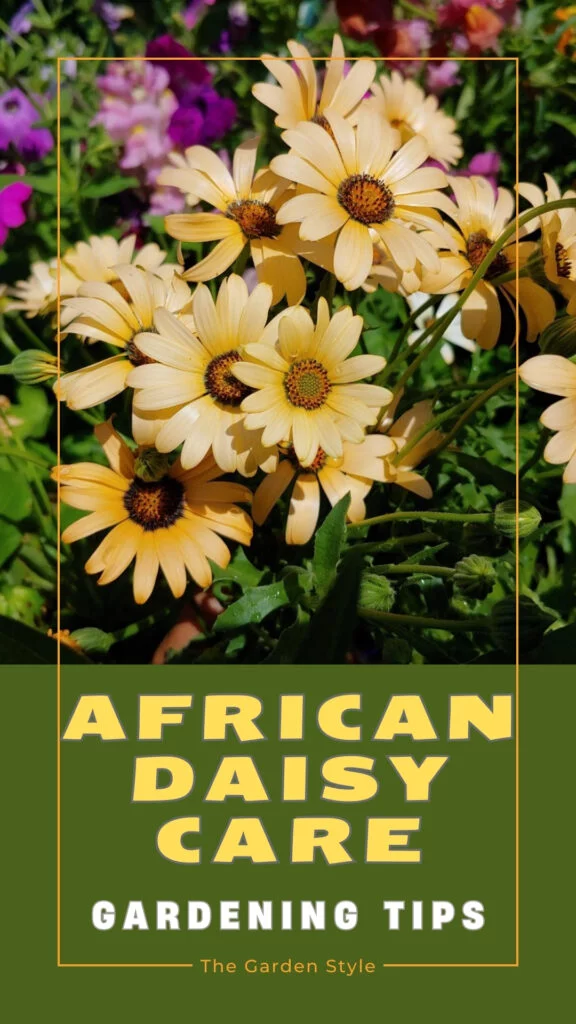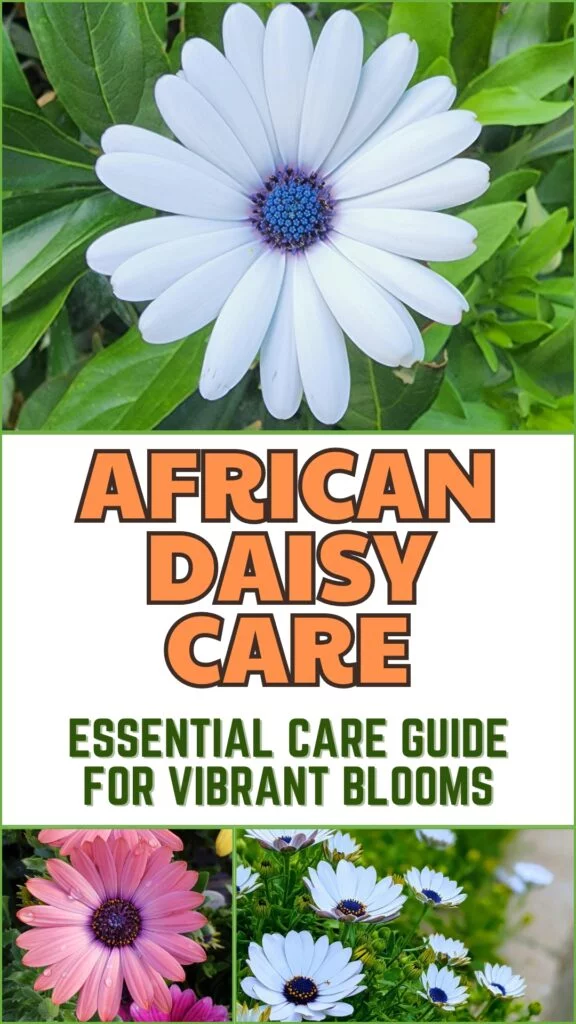African daisies are the perfect pick for adding a burst of sunshine to your garden. With their cheerful blooms and hardy, low-maintenance nature, these plants are a favorite among novice and experienced gardeners alike. In this comprehensive guide on how to take care of African daisies, we’ll dive into everything you need to know to grow and care for these delightful flowers successfully.
Table of Contents
What are African Daisies (Osteospermum)?
African daisies, scientifically known as Osteospermum, are a genus of flowering plants native to Africa and the Mediterranean region. These sun-loving beauties belong to the Asteraceae or daisy family and are characterized by their bright, daisy-like flowers in shades of yellow, orange, purple, and white.
The most common varieties include Osteospermum jucundum (African daisy) and Osteospermum ecklonis (Cape daisy). These hardy plants can be grown as annuals or perennials, depending on the climate. They typically grow to about 12-18 inches tall and spread up to 2 feet wide, creating a vibrant carpet of color in the garden.
Other popular African daisy varieties include the Osteospermum hybrids like ‘Serenity’ and ‘Passion Mix,’ known for their unique bi-colored blooms and long flowering period.
African daisies are prized for their easy-care nature, drought tolerance, and ability to bloom continuously from spring through fall when provided with the right growing conditions.
How to Take Care of African Daisies (also known as Cape Daisies)
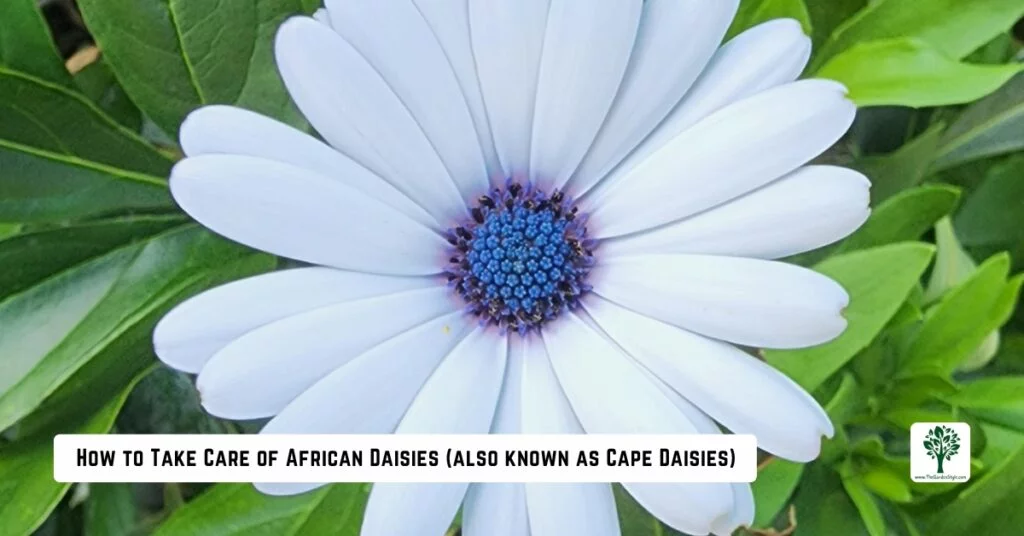
To thrive, African daisies require specific growing conditions that mimic their native habitat. Let’s explore their ideal environment:
Sunlight Requirements
African daisies are sun-worshippers and perform best in full sun exposure. They need at least six hours of direct sunlight per day, although, in extremely hot climates, they may appreciate some afternoon shade to prevent wilting.
Soil Preferences
These plants prefer well-draining, fertile soil with a slightly acidic to neutral pH range between 6.0 and 7.5. They can tolerate somewhat sandy or rocky soils but struggle in heavy clay or consistently wet conditions.
Temperature and Humidity
African daisies are heat-lovers and can easily tolerate high temperatures, making them a perfect choice for warm climates. They also have a moderate drought tolerance once established.
As for humidity, they prefer drier conditions and may struggle in overly humid environments, which can lead to fungal issues.
Planting and Maintenance
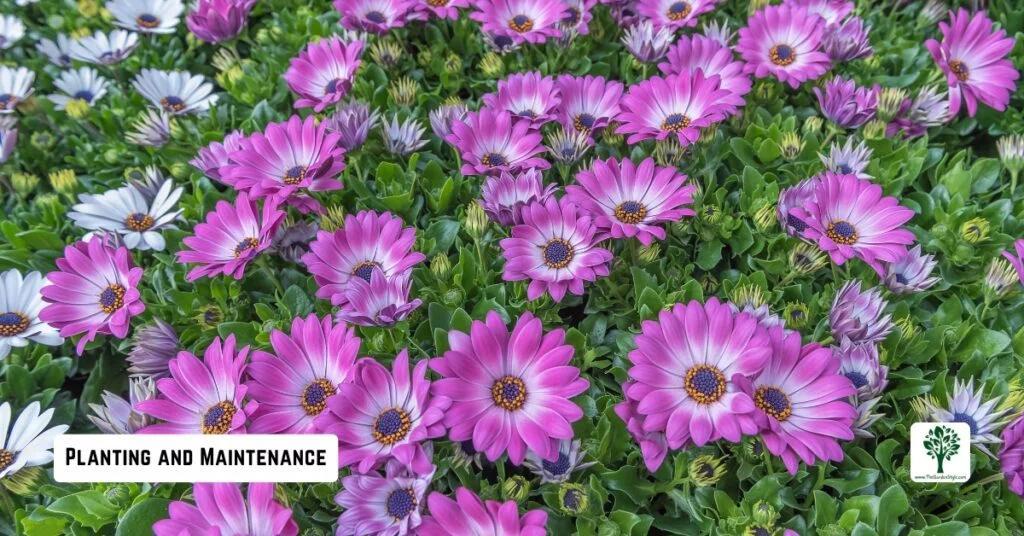
Whether you’re starting from seeds or transplants, African daisies are easy to establish in the right conditions.
From Seed
If you’re growing African daisies from seed, start them indoors about six to eight weeks before the last expected frost date in your area. Sow the seeds in a well-draining seed-starting mix, lightly cover them with soil, and keep the soil consistently moist until germination occurs (typically within 7-14 days).
Once the seedlings have their first set of true leaves, you can begin hardening them off by gradually exposing them to outdoor conditions for a week or two before transplanting.
Transplanting
When transplanting seedlings or purchasing nursery plants, choose a sunny spot with well-draining soil. Space the plants about 12 inches apart to allow for their eventual spread.
After planting, water them thoroughly, and continue to water regularly, keeping the soil moist but not waterlogged. Mulching around the plants can help retain moisture and suppress weeds.
Fertilizing African Daisies
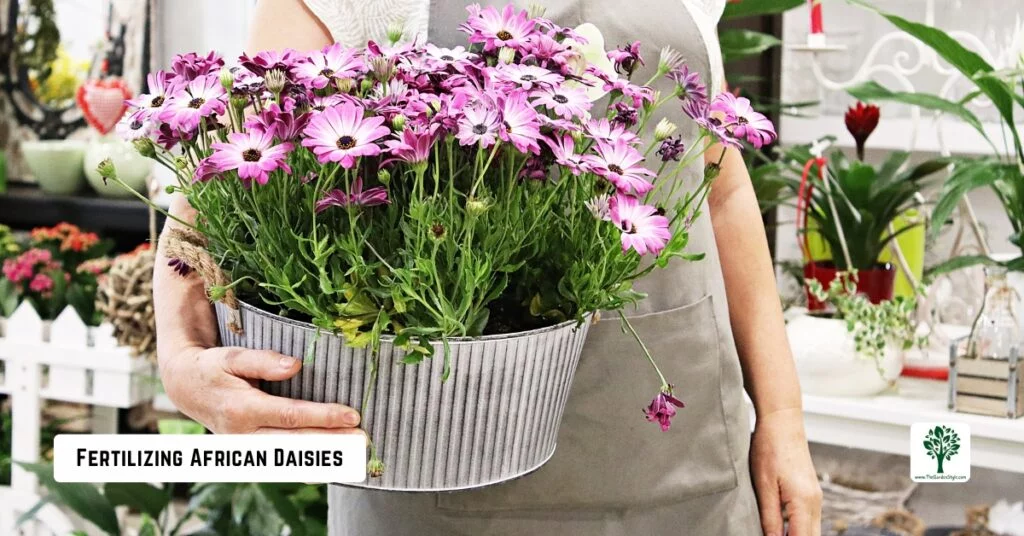
African daisies benefit from regular fertilization to promote healthy growth and abundant blooms. Use a balanced, water-soluble fertilizer every six to eight weeks during the growing season, following the product’s instructions.
- Designed to produce more flowers and brighter colors on all indoor and outdoor plants, Blossom Booster is a professional formula that feeds through both the roots and the leaves.
- Formulation helps to product amazing results with proven 1:3:2 nutrient ratio
Pruning, Pinching Off, and Deadheading
It’s important to deadhead spent blooms regularly to encourage continuous flowering. Simply pinch off or snip the faded flowers just below the bloom with your fingers or pruners.
You can also prune back leggy or overgrown plants by about one-third to promote bushier growth and more blooms.
Common Pests and Diseases
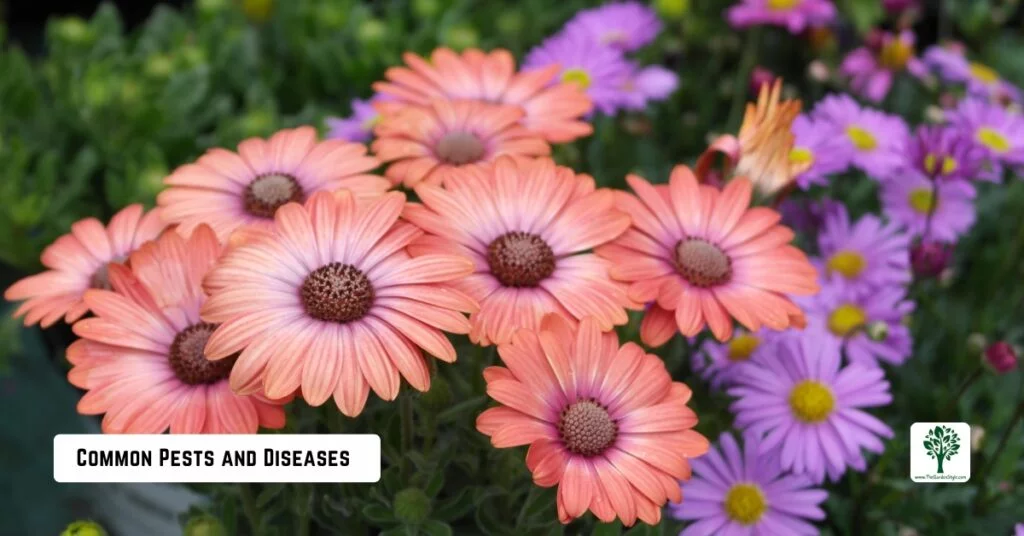
While generally hardy and resistant to most pests and diseases, African daisies can occasionally face a few issues. Here are some common problems and their solutions:
Pests
- Aphids: These small, sap-sucking insects can infest the plants, causing stunted growth and distorted leaves. Use insecticidal soap or neem oil to control them.
- Spider mites: These tiny pests can create webbing on the undersides of leaves and cause discoloration. Regularly hose down the plants with water to dislodge them, or use an insecticidal soap or neem oil spray.
Diseases
- Powdery mildew: This fungal disease appears as a white, powdery coating on the leaves and stems. Improve air circulation around the plants and apply a fungicide if necessary.
- Root rot: This can occur if the plants are consistently overwatered or planted in poorly draining soil. Ensure proper drainage and let the soil dry out between waterings.
Other Issues
- Wilting: African daisies may wilt in extremely hot or dry conditions. Provide afternoon shade and consistent moisture to prevent this.
- Leggy growth: If the plants are not receiving enough sunlight, they may become leggy and stretched out. Prune them back and ensure they receive at least six hours of direct sun per day.
Companion Plants for African Daisies
Companion planting involves strategically placing plants together in the garden to enhance growth, repel pests, and improve overall garden health. With their vibrant blooms and easy-to-care-for nature, African daisies can benefit from companion planting. By selecting the right companions, gardeners can create a harmonious ecosystem where plants support each other’s growth and well-being. Here, we explore some ideal companion plants that complement African daisies, enhancing both aesthetics and garden productivity.
- Lavender: Both African daisies and lavender thrive in similar conditions of well-drained soil and full sun. Plus, they complement each other beautifully in terms of color and fragrance.
- Salvia: These flowers attract pollinators like bees and butterflies, benefiting African daisies. They also share similar care requirements.
- Marigolds: Marigolds repel certain pests that might bother African daisies, making them great companions in the garden. Plus, their vibrant colors add visual interest.
- Alyssum: Alyssum is a low-growing plant that creates a lovely ground cover around African daisies. It also attracts beneficial insects like hoverflies and predatory wasps.
- Coreopsis: Coreopsis, with its cheerful daisy-like flowers, complements African daisies nicely and also attracts pollinators to the garden.
- Catmint: Catmint is known for its ability to repel pests while attracting beneficial insects. It also adds a soft, billowy texture to the garden when planted alongside African daisies.
- Russian Sage: This perennial herb not only adds height and texture to the garden but also attracts pollinators and repels certain pests that might harm African daisies.
Here’s a table summarizing the companion plants for African daisies:
| Companion Plant | Benefits |
| Lavender | Similar care requirements, color, and fragrance complement |
| Salvia | Attracts pollinators, similar care needs |
| Marigolds | Repels pests, adds vibrant color |
| Alyssum | Ground cover, attracts beneficial insects |
| Coreopsis | Attracts pollinators, complements African daisies |
| Catmint | Repels pests, attracts beneficial insects, adds texture |
| Russian Sage | Adds height and texture, attracts pollinators, repels pests |
These companion plants can create a harmonious and thriving garden alongside African daisies.
Propagating African Daisies
One of the best things about African daisies is how easy they are to propagate. You can readily increase your supply through three methods:
From Seeds
Collect seeds from existing plants once the blooms have faded and dried out. Store them in a cool, dry place until the next growing season, then sow them as described earlier. Learn more about how to grow African daisies from seed.
Division
Established African daisy plants can be divided every few years in early spring or fall. Carefully dig up the entire clump and separate the roots into smaller sections, replanting them immediately in their new locations.
From Cuttings
Using African Daisies in Your Garden
With their profuse blooms and cheerful colors, African daisies have numerous applications in the garden. Here are some popular ways to showcase these beauties:
Bedding Plants: African daisies make exceptional bedding plants, adding a vibrant pop of color to borders, rock gardens, or along walkways and paths. Their compact size and spreading habit create a stunning carpet of blooms.
Container Gardening: These plants also perform well in containers, where their trailing habit can spill over the sides for a charming effect. Use a well-draining potting mix and a sunny location.
Cut Flowers: If you’re looking for long-lasting cut flowers, African daisies are an excellent choice. Simply snip the blooms in the morning and place them in a vase of fresh water. They’ll last for several days, brightening up any room. Learn more about how to start a cut flower garden: plan and layout.
Frequently Asked Questions
African daisies are prolific bloomers, typically flowering from early spring through late fall, providing months of vibrant color in the garden.
While most varieties are grown as annuals, some species of African daisies, such as the Dimorphotheca pluvialis, can be perennial in warmer climates (USDA zones 9-11).
Yes, once established, African daisies have moderate drought tolerance and can withstand periods of dry weather, although they’ll perform best with consistent moisture.
Yes, African daisies require full sun exposure, meaning at least six hours of direct sunlight per day, to thrive and bloom profusely.
To deadhead African daisies, simply pinch or snip off the spent blooms just below the flower head with your fingers or pruners. That will encourage more blooms to form and extend the flowering season.
If this post about how to take care of African daisies from seed was helpful, please share it:
